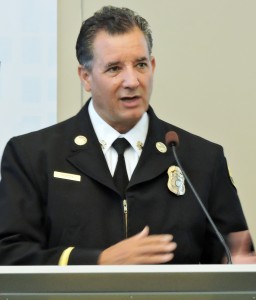During a talk at the Newport Beach Chamber of Commerce Wake Up Newport! Meeting on Thursday, Newport Beach Fire Chief Scott Poster gave a fact-packed presentation that offered an overview of the department while addressing the information which he said most people ask about.
The NBFD employs 148 full time people, including 119 who are sworn firefighters. Thirty-nine are on duty at any given time at eight fire stations strategically located throughout the city so that response time to a call is between six and eight minutes max.

— Photo by Richard Simon ©
There are two ambulances with two Orange County Accredited and Certified paramedics in each. Since the majority of calls are of medical nature, Chief Poster is making sure that the majority of firefighters are paramedic qualified, as he sees the department as a “medical force”
Chief Poster explained that an effective medical force consists of five responders, each with a particular life-saving responsibility. Since an ambulance crew numbers two, and a fire truck is manned by three, that is why citizens always see at least two emergency vehicles on scene.
In terms of numbers, he said that an effective fire fighting force comprises a minimum crew of 16. Depending on the type of fire – dwelling, business or warehouse or high rise – crew size will vary.
Crewmembers undertake a variety of jobs, from extinguishing flames to hazardous materials handling, search and rescue, medical, and more.
Because we are an ocean-based community, Marine Operations are a major process. During peak season between May and September, lifeguard numbers swell with up to 200 seasonal lifeguards—mostly college students who return to serve during summer breaks.
Lifeguard coverage spans 14 hours a day, and every beach is manned. Off-season, a small regular staff can patrol the mostly deserted beaches 11 to 13 hours daily. Big Corona beach is observed via remote camera.
Chief Poster cited Newport’s award-winning Community Emergency Response Team (CERT) program as being an important adjunct to the department. CERT is peopled by civilians who undergo many weeks of training in order to assist their neighborhoods during widespread emergencies.
Currently, said Chief Poster, the strategic plan in the works emphasizes “Faster, Smaller and Smarter,” all while keeping within the department’s $37 million budget.




